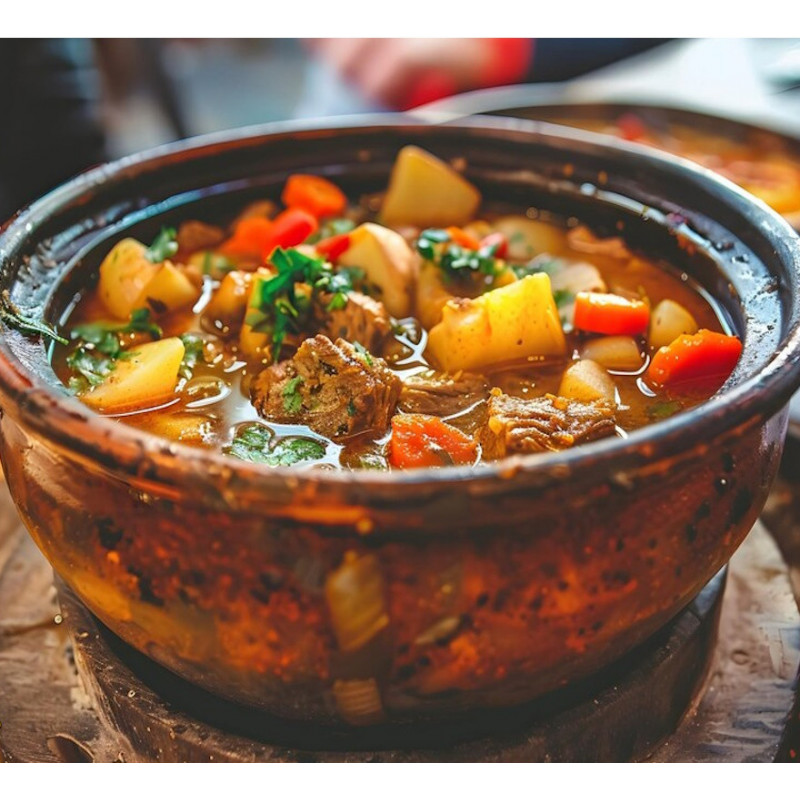Cocido - Spanish Meat and Vegetable Stew (19th Century)
 Garanties sécurité
Garanties sécurité
(à modifier dans le module "Réassurance")
 Politique de livraison
Politique de livraison
(à modifier dans le module "Réassurance")
 Politique retours
Politique retours
(à modifier dans le module "Réassurance")
The origin of cocido
Cocido has a long history in Spain, and the first codified versions of this dish date back to the 16th century. However, it was during the following centuries that it became a central dish in Spanish gastronomy, with regional versions multiplying.
First mentions and codifications of cocido
Cocido in medieval and Renaissance cuisine:
Cocido, like many traditional Spanish dishes, has its roots in medieval soups and stews. This type of dish was designed to be nutritious, hearty, and ideal for feeding large families or groups. Ancient recipes, often codified in cookbooks, include preparations of boiled meats, often accompanied by chickpeas or vegetables available according to the season.
The first written mentions of recipes similar to cocido can be found in cookbooks from the 16th century, during the Spanish Renaissance. However, the cocido as we know it today began to take shape and differentiate from other types of simpler soups and stews in the 17th and 18th centuries.
First modern codification (18th century)
One of the first codifications of a cocido resembling the modern version was made within the context of Spanish royal cuisine. In the 18th century, royal kitchens played an important role in formalizing many traditional dishes. The "Cocido de Madrid" (one of the most famous types of cocido) appeared at this time in cookbooks and recipe books.
One of the first books to mention more codified versions of this dish is Martino de la Cruz's "Arte de Cocina" (1560), which describes stew dishes made from meats, vegetables, and sometimes chickpeas, but does not provide an exact recipe for what is now recognized as cocido. It is rather a type of meat stew, similar to the early European "pottages."
Codification in 19th-century Spanish cuisine:
It was in the 19th century, with the rise of bourgeois cuisine and the publication of works such as Raimundo Díaz de Elías's "La Cocina Completa" (1885), that cocido truly took form. It began to distinguish itself from other soups and meat-based dishes.
By the 19th century, with the unification of culinary traditions under centralizing influences like Madrid, cocido began to include specific ingredients, such as:
- Meats: pork, beef, chicken, sometimes blood sausage.
- Vegetables: chickpeas, carrots, celery.
- Salted meat, sometimes bacon or ham, to add flavor.
Evolution into the modern version (20th century)
With the publication of more detailed recipes in cookbooks such as Margarita Ruiz's "Cucina Española" and 20th-century cookbooks, cocido began to diversify into regional versions. For example, cocido madrileño (which includes vegetables, meat, chickpeas, and cold meats like blood sausage), cocido maragato (with boiled meats served separately), or cocido andaluz, influence the way cocido is prepared and served throughout Spain.
Codified old recipe for cocido (19th century)
A codified version of cocido, close to the one served today, might look like this:
Ingredients (19th-century codified version):
- Meats: 500 g of beef (usually shank), 300 g of pork (belly, bacon), and 200 g of chicken.
- Vegetables: 2 carrots, 1 stalk of celery, 1 onion, 2 potatoes.
- Legumes: 250 g of chickpeas soaked overnight.
- Spices: Salt, pepper, a few bay leaves, 1 branch of thyme.
- Additions: 1 piece of smoked bacon (optional).
Preparation:
- Soak the chickpeas in cold water the night before to soften them.
- Boil the meats: In a large pot, place the meat pieces, the onion studded with cloves, the vegetables (carrots, celery, potatoes), and the herbs. Cover with cold water.
- Simmer: Bring to a boil, then lower the heat and let it simmer for 2 to 3 hours.
- Add the chickpeas to the pot about an hour before the cooking is finished.
- Serve: The cocido is served in several stages: first the broth, then the meats and vegetables. Sometimes, a light broth dish is served first, followed by the meats and vegetables on a separate plate.
The cocido, as it was codified in the 19th century, was a hearty and nourishing dish that represented a complete meal for families. Each region later developed its own variations based on local ingredients, culinary preferences, and historical influences.
Conclusion
Although cocido has humble and medieval origins, it was gradually codified in the 18th and 19th centuries, primarily through the popular cookbooks of the time. These early codified recipes contributed to the birth of the many regional variants we find today in Spain, making this dish a symbol of traditional Spanish cuisine.


